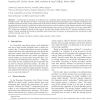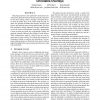285 search results - page 39 / 57 » Intrusion-Resilient Public-Key Encryption |
JCST
2010
13 years 2 months ago
2010
In this paper we introduce an architecture for a multi-key pirate decoder which employs decryption keys from multiple traitors. The decoder has built-in monitoring and self protect...
STOC
2005
ACM
14 years 8 months ago
2005
ACM
Our main result is a reduction from worst-case lattice problems such as GAPSVP and SIVP to a certain learning problem. This learning problem is a natural extension of the `learnin...
NSDI
2007
13 years 10 months ago
2007
This paper proposes a new approach to anonymous communication called information slicing. Typically, anonymizers use onion routing, where a message is encrypted in layers with the...
IJNSEC
2007
13 years 7 months ago
2007
We describe an identity based signature scheme that uses biometric information to construct the public key. Such a scheme would be beneficial in many repudiation situations for e...
EUROCRYPT
1998
Springer
13 years 12 months ago
1998
Springer
Abstract. This paper introduces a cryptographic paradigm called selfescrowed encryption, a concept initiated by kleptography. In simple words, a self-escrowed public-key cryptosyst...


